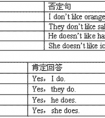Fillintheblankswiththerightformsofthegivenwords. 用所给单词的适当形式填空。1.Iwant(buy)agiftformyfamily.2. Theflag(cost)onedollar.3. "It'sagoodidea." s-六年级英语
The police are looking for him. 警察在找他。
Many cattle were killed for this. 就因为这个原因宰了不少牲畜。
注:表示牲畜的头数,用单位词 head(单复数同形)。如:five head of cattle 5头牛,fifty (head of ) cattle 50头牛
第三类
形式为复数,意义也为复数这类集合名词
包括goods(货物),clothes(衣服)等。
其用法特点是:
只有复数形式,当然也表示复数意义,用作主语时谓语也用复数),但通常不与数词连用。
如:Clothes dry slowly in the rainy season. 衣服在雨季不易干。
Such clothes are very expensive. 那样的衣服很贵。
If goods are not well made you should complain to the manufacturer. 如果货物质量不好,则理应向制造商提出控诉。
第四类
形式为单数,意义也为单数这类集合名词
包括baggage / luggage(行李), clothing(衣服), furniture(家具), machinery(机器), poetry(诗), scenery(风景), scenery(), jewelry(珠宝), equipment(设备)等。
其用法特点为:
是不可数名词,只用单数形式,不用不定冠词(当然更不能用数词),没有复数形式。
如:Our clothing protects us from [against] the cold. 我们的衣服可以御寒。
Have you checked all your baggage? 你所有的行李都托运了吗?
The thief stole all her jewelry. 小偷把她所有的首饰都偷走了。
The hospital has no decent equipment. 这家医院没有像样的设备。
The Tang Dynasty is thought of as the high summer of Chinese poetry. 人们认为唐朝是中国诗歌的全盛时期。
注:machinery, poetry, jewelry, scenery等相应的个体可数名词是 machine, poem, jewel, scene等。
如:a poem / a piece of poetry 一首诗
many machines / much machinery / many pieces of machinery 许多机器
第五类
补充几个常考的集合名词除上面提到的四类集合名词外,以下几个集合名词也应重点注意:
1. hair(头发,毛发)
指全部头发或毛发时,为集合名词(不可数);指几根头发或毛发时,为个体名词(可数)。
如:My hair has grown very long. 我的头发已长得很长了。
The police found two hairs there. 警察在那儿找到了两根头发。
2. mankind(人类)
人是一个不可数的集合名词,不用复数形式,也不连用冠词。
如:This is an invention that benefits mankind. 这是一项造福人类的发明。
Mankind has its own problems. 人类有自己的问题。
注:mankind 表示“mankind 人(类)”时,虽不可数,但有时却可以表示复数意义,尤其是当其表语是复数时。
如:Mankind are intelligent animals. 人是理智的动物。
3. fruit(水果)
作为集合名词,它通常是不可数的。
如:He doesn’t eat much fruit. 他不大吃水果。
He is growing fruit in the country. 他在乡下种水果。
但是,当要表示种类时,它可视为可数名词,即a fruit 指一种水果,fruits 指多种水果。
比较:fruits Some fruits have thick skins. 有些水果皮很厚。
The potato is a vegetable, not a fruit. 土豆是一种蔬菜,而不是一种水果。
考点名称:副词
- 副词:
用来修饰动词、形容词、其他副词或全句的词,表示时间、地点、程度、方式等。 - 分 类:
1) 时间和频度副词:
now,then,often,always,usually,early,today, lately, next,last,already,generally,frequently, seldom,ever,never,yet,soon,too, immediately, hardly,finally,shortly, before, ago,sometimes, yesterday.
2) 地点副词:
here, there, everywhere, anywhere, in, out, inside, outside, above, below, down, back, forward, home, upstairs, downstairs, across, along, round , around, near, off, past, up, away, on.
3) 方式副词:
carefully, properly, anxiously, suddenly, normally, fast, well, calmly, politely, proudly, softly, warmly
4) 程度副词:
much,little, very,rather,so,too,still, quite, perfectly, enough, extremely, entirely,almost, slightly.
5) 疑问副词:
how, when, where, why.
6) 关系副词:
when, where, why.
7) 连接副词:
how, when, where, why, whether. 副词的位置:
A、副词修饰动词(包括动名词和分词)时,通常位于被修饰动词的后面。
例:Shestudieshard.她学习努力。
B、副词修饰形容词是,通常放在该形容词的前面。
例:LiMingistooyoung.Hecan’tcarrytheheavybox. 李明太小,他搬不动这个重箱子。
C、副词修饰其他副词时,通常放在被修饰副词的前面。
例:Thegirlsingsverywell.这个女孩歌唱得非常好。副词用法:
副词在句中可作状语,表语,补语。
He works hard.
他工作努力。
You speak English quite well.
你英语讲的很好。
Is she in ?
她在家吗?
Let's be out.
让我们出去吧。
Food here is hard to get.
这儿很难弄到食物。
考点名称:一般现在时,动词单数第三人称
一般现在时:
表示现在经常反复发生的动作、存在的状态或习惯性的动作的时态。可概括为
①经常性或习惯性动作;
②长期存在的特征或状态;
③普遍真理、客观事实等。
构成:
一般现在时用行为动词的原形,但第三人称单数作主语时,动词的词尾要加-S。
a. 表示经常性或习惯性的动作。
例:Li Ming always helps the old man. 李明一直帮助这位老人。
We usually go to school on foot. 我们通常步行上学。
They sometimes go fishing on Sundays. 他们有时周日去钓鱼。
b. 表示永恒不变的事实或真理。
例:A bird flies with wings. 鸟用翅膀飞翔。
c. 用在格言、谚语中。
例:Pride goes before a fall. 骄者必败。- 一般现在时具体用法:
1.表示经常的或习惯性的动作,常与表示频率的时间状语连用。
时间状语:
always,usually,every morning/night/evening/day/week/year,often,sometimes,
occasionally,from time to time,twice a week,rarely,seldom,once a month,hardly,ever,never.
e.g: I leave home for school at 7:00 every morning.
2.表示主语具备的性格、能力、特征和状态。
e.g:I don't want so much.
Ann Wang writes good English but does not speak well.
比较:Now I put the sugar in the cup.
I am doing my homework now.
3.表示客观事实和普遍真理。
e.g :The earth moves around the sun.
Shanghai lives in the east of China.
4.在时间状语从句和条件状语从句中,常用一般现在时代替将来时。
5.表示预先计划或安排好的行为。
6.小说故事用一般现在时代替一般过去时。新闻报道类的内容,为了体现其“新鲜”性,也用一般现在时来表示过去发生的事情。
7.有些表示状态和感觉的动词表示现在发生的具体行为时,只用一般现在时,而不用进行时态。
8.表示现在发生的具体动作或存在的状态
9表示格言或警句中。 e.g Pride goes before a fall. 骄者必败。
注意:此用法如果出现在宾语从句中,即使主句是过去时,从句谓语也要用一般现在时。
例:Columbus proved that the earth is round..
第一句用一般现在时,用于操作演示或指导说明的示范性动作,表示言行的瞬间动作。
再如:Now watch me,I switch on the current and stand back.
第二句中的now是进行时的标志,表示正在进行的动作的客观状况,所以后句用一般现在时。 - 一般现在时用法表:

第三人称单数的构成见下表:


![I want to ______________a science teacher one day![ ]A. beB. isC. are-六年级英语](http://www.00-edu.com/d/file/ks/4/1/58/2019-08-28/small0786c619dff6ea7cc013f1222e770e571566922364.png)
![Let's get ____ work![ ]A. on B. inC. to-四年级英语](http://www.00-edu.com/d/file/ks/4/1/58/2019-08-28/smallaeead033e0df4ab64ad92e4eecbe84ed1566922686.png)
![It's 10 o'clock. It's time_________go to school.[ ]A. toB. forC. of-四年级英语](http://www.00-edu.com/d/file/ks/4/1/58/2019-08-28/smallcbd5ebed803baef3505fe0cd5bc985461566922628.jpg)

